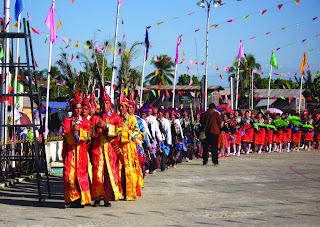For the benefit of the Singaporean crowd, no, we're not talking about hornbills pickled in the drink bandung *shudder*. These are hornbills spotted in an ill-maintained(if one can even consider what little they seem to do maintenance) zoo in Bandung, Indonesia. While in the wild these amazing birds would have very large ranges of kilometers of land, just for the benefit of mankind, they have been crammed into relatively tiny enclosures and expected to just deal with it. That's a whole different story we shall not get into; we'll just focus on the hornbills. Or at least, we'll try. No promises.
There were two tiny enclosures housing wreathed hornbills and oriental pied hornbills- both of which can be found in Java, assuming they haven't all been stolen from the wild to be sold in the infamous bird market in Yogyakarta, or put in other tiny enclosures around Indonesia. *oops...there we go again...*
 |
| Hornbill enclosure in the forefront of the picture |
 |
| In the shadows (Rhyticeros/Aceros undulatus) |
 |
| Wreathed hornbill (Rhyticeros/Aceros undulatus) |
 |
Wreathed Hornbills(Rhyticeros/Aceros undulatus) |
 |
| Oriental Pied Hornbills |
Indonesia is home to many different species of hornbills, including the Wreathed and Oriental pied hornbills in the pictures above. However, it is important to note that not all the species can be found on every island. Also, some islands of the Indonesian archipelago have endemic species of hornbills, found nowhere else except in those couple of islands. Island populations are often known to harbour endemic species of organisms simply because they are, to a certain extent, cut of from "the rest of the world" or more accurately, from other populations of hornbills. After a couple of hornbills have painstakingly got their feathery behinds to some remote island, one of two possibilities is likely to occur(there are other possibilities apart from the ones stated here, of course...):
- They are unable to survive in this new, exotic environment and die out.
- They manage to survive long enough to reproduce, enabling natural selection to take over and soon enough, you (possibly) have an entirely new species of hornbill. One that is more adept at facing what the island throws at them.
Wreathed Hornbills
Big Wreathed hornbills are known to start making miniature wreathed hornbills at around 3 to 4 years old. In Indonesia and Malaysia, they are believed to nest throughout the year. Interestingly, these hornbills have ridges on their casques. These ridges are a rough indication of age since they accumulate ridges as they mature. You might be wondering what the point of knowing how old(or young, for all you age-sensitive folk out there) a hornbill is. Seeing as how no one has been able to master hornbill-speak, nerdy scientists with big, groovy brains have had to make some intelligent guesses and test out these guesses using the all important scientific method. This is what they've come up with so far:
Generally, hornbills' ability to make babies that survive to a ripe old age (and produce more babies of their own along the way) increases as they get older... up to a particular point, where it reaches a maximum and then, their ability to produce healthy babies decreases once again.It is believed that this is due to their increased ability to provide lots of nutritious food to the self-imprisoned mother and baby hornbills.
Why do older birds provide provide better for their families? Having more ridges may give the bird a higher "status", as compared with hornbills with fewer ridges on their casques. This enables their all mighty feathery behinds to shoo away younger birds when getting food, i.e. they get the best pickings!
So let's say you're a female hornbill. Which potential Mr. Right are you on the look out for? The hornbill with fewer ridges and is only mediocre at providing for you and your babies... or the hornbill with a whole load of ridges and is well equipped to provide well for you and your babies?You decide :)
References
BirdLife International (2010) Species factsheet: Aceros everetti. Downloaded from http://www.birdlife.org on 9/9/2010
Kemp, A. (1995). The Hornbills. United States: Oxford University Press Inc., New York.
Kemp, A. (1995). The Hornbills. United States: Oxford University Press Inc., New York.
http://evolution.berkeley.edu/evosite/evo101/index.shtml



























